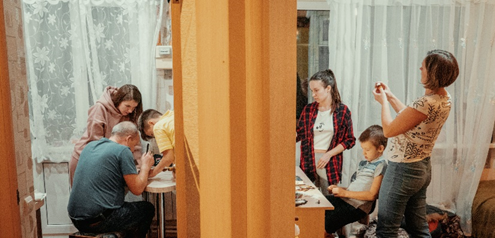
Millions of U.S. households have multiple adult generations. How do they divide up the worth of their home and the upkeep that goes into it? Who pays the mortgage, insurance, and property taxes? What happens if an owner leaves the home, or passes away?
A lot comes down to good deed planning.
In this discussion of vesting a multigenerational home, we check out the intersections of people’s lives and deeds.
Why Multigenerational?
People who grow up in multigenerational homes may have fond memories of the time they enjoyed with their grandparents. Some want to give their own kids similar experiences.
Some families want to share their financial strength with their kids or their parents. They combine their resources to meet their goals.
And, depending on those goals, there are many ways to name people on the deed. Owners are wise to do some research before gifting real estate or forming co-ownerships. Different deed options (gift, probate, or trust) lead to different tax results (think capital gains) when a home is later sold!
Learn why passing a home along through your will or trust could turn out to be the best choice for tax planning.
Real-Life Scenarios Illustrating Different Vesting Options
The Johnson Family – Tenants in Common
The Johnsons, three adult siblings, own their family home as tenants in common. When the eldest, Michael, passes away, his share becomes part of his estate, demonstrating the individual control each tenant in common has over their property share.
The Smith Family – Joint Tenants with Right of Survivorship (JTWROS)
Mary and her mother, Ellen, co-own their home as JTWROS. Upon Ellen’s passing, Mary automatically inherits her mother’s share, showcasing how JTWROS simplifies the transition of property ownership without probate.
The Gomez Family – Trust Ownership
The Gomez family places their ancestral home in a trust, ensuring it remains within the family across generations. This case exemplifies how a trust can manage property according to predefined rules, avoiding probate and maintaining family continuity.
The Davis Family – Life Estate
Harold Davis sets up a life estate for himself in his home, with his daughter, Jenna, as the remainderman. After Harold’s passing, Jenna automatically inherits the home, bypassing probate. This scenario highlights the benefits of life estates in ensuring smooth property transitions.
The Big Issue: How to Name Co-Owners on the Deed
They could vest the deed as tenants in common (TIC). It’s a basic option for homeowners who prefer to keep and control their portion of ownership.
Tenants in common can co-own the home by any percentages they like. The deed states who owns what percent.
Co-owners can pass their portion of the property value on. The ownership share of a co-owner who dies goes to the person named in the last will of the deceased.
For tenants in common, there will be probate!
Using Survivorship Rights to Bypass Probate

Joint tenants with the right of survivorship (JTWROS) is a popular pick for family members. With JTWROS, when a co-owner passes on, that person’s ownership interest automatically transfers into, and enlarges, the ownership interest of the co-owner(s).
Survivors bring the death certificate to the county recorder’s office. They claim their property interests without any need to put the home through probate.
Does bypassing probate through the right of survivorship keep the home off-limits to a senior owner’s creditors? Not necessarily. If a senior co-owner needs to move to receive professional care, Medicaid could claim some of your home equity to cover those care costs. Take time to learn about the ramifications of bringing a senior household member onto the deed. The idea that seniors can quitclaim a home to themselves and joint owners to shield the home’s value is a question for an elder or estates law practitioner in the state where the home exists.
Before creating a new deed to add owners, call your licensed professionals. Learn whether and how your homestead exemption (if any), your secured loans, and any title insurance will be impacted. Forgetting about the local homestead exemption on property taxes could be costly.
Trusts Can Also Take Care of Generations
A trust can do so much to memorialize and carry out everyone’s wishes. It can answer questions like:
- Who lives in the home?
- How is caregiving and home maintenance repaid?
- How do we level out the contributions and the division of property value across the group?
- Who gets first priority as a buyer if the home is sold upon a deed holder’s death?
- What happens if the arrangement just doesn’t work out?
A trust can lay out what happens in case of unplanned or unusual events. Trusts can be revocable or irrevocable, and can be used to pass the home through the generations, avoiding transfer tax. With a lawyer’s help, the multigenerational household can create a trust to spell out the terms effectively.
How did the co-owners vest the property? (The vesting might override other written directions.)
Everyone who signs the trust documents should check that their wills do not contradict anything in the trust.
Welcoming a Parent Into Your Household?
Your tax professional, or a law firm that deals with estates and trusts, can offer situation-specific guidance. For example, whether it’s a good or bad idea to add your parent to the deed will depend on your family’s circumstances.
In some cases, putting a parent on the deed doesn’t make sense. It can create a complicated estate or undo a homestead exemption.
Deeding a home into the name of a family trust might be right for one household. For another, a rental arrangement is the best way to meet intergenerational goals.
A trust can also be a financial tool. It can hold household maintenance funds. This can avert the passing-down of a big home that makes the younger generation house-rich, but cash-poor.
Much depends on how well the potential heirs plan together, and what everyone agrees should be done with the home in the event that any co-owner dies.
The Life Estate: Deeding a Home for Life
Some multigenerational homes include elder members with life estates. This is an effective way to transfer a home into a co-ownership. A life estate entitles one household member to live in the home for life. Like joint ownership with survivorship rights, this legal arrangement avoids probate. It’s all about creating the right deed.
So, the life tenant could be a parent. After the parent passes on, the surviving co-owner receives the “remainder” of the ownership interest. The home would need to be deeded “to [parent’s name] for life, then to [adult child’s name] as the remainder.” (In the unlikely scenario that the adult child dies before the parent does, the adult child’s heirs will receive co-ownership with the elder owner.)
Sign and record it in the home’s county, and the world is on notice that one party holds homeownership rights and duties for life.
What comes after life? The title passes to the next generation based on the recording of the life estate deed and, now, the death certificate. There’s no need for probate.
Read up on Medicare and Medicaid liens, and know the right questions to ask an estate planning professional.
For Shared Ownership, Trust Is Key
The parent can consent to the adult child living in the home if they want to create a multigenerational household through a life estate deed. Yes, consent! Everyone has to agree to their part.
How will one owner feel about needing each other’s go-ahead before borrowing against the home, for instance? And if the parties ever decide to sell, they’ll split any gains according to the IRS-directed rule (PDF).
Meanwhile, co-owners must be confident that they have each others’ backs. Each must count on respect from the other(s) for co-ownership to work. Imagine the worst-case scenarios before making the commitment. As one financial writer, Dana George, memorably puts the point:
If, for instance, you are injured and go into a coma, could you trust that other person (or people) to ensure everything is paid in full until you awake? If not, think twice about cosigning anything.
Finally, check to see if the “enhanced” life estate deed exists in your home’s state. Also called the lady bird deed, it empowers a life tenant to sell or refinance, to revoke or change where the remainder will go after death.
Every Household Has Its Own Signature Energy
Your tax specialist can guide you through the deed’s potential impact on your gift tax exclusions and any state taxes due. A financial adviser can help ensure your estate planning documents match your and your family’s goals.
Each household has unique thoughts about the best way to pass their home’s value along to future owners. No answer works for everyone. But after reading this, you and your family members should be ready to ask the right questions.
In conclusion, the choices surrounding multigenerational homeownership and how the deed is vested are pivotal in determining the management, succession, and financial implications of a shared family home. As we’ve seen through various real-life scenarios like the Johnsons, Smiths, Gomezes, and Davises, each vesting option – whether Tenants in Common, Joint Tenants with Right of Survivorship, Trust Ownership, or Life Estate – offers distinct advantages and considerations.
- Tenants in Common allows individual control over each owner’s share, making it suitable for families who want flexibility in estate planning.
- Joint Tenancy with Right of Survivorship ensures a smooth and immediate transfer of property to surviving co-owners, bypassing the probate process.
- Trust Ownership provides a structured approach to managing and passing down property across generations, ensuring continuity and adherence to the family’s wishes.
- Life Estates offer a unique way to manage property rights during an owner’s lifetime while ensuring a predetermined transition after their passing.
Each family’s situation is unique, and the right choice depends on their specific needs, goals, and circumstances. It’s crucial for families to consider all aspects – legal, financial, and personal – when deciding how to vest their home’s deed. Consulting with legal and financial professionals is highly recommended to navigate this complex but crucial part of family estate planning.
By understanding these options and carefully planning, families can ensure that their multigenerational home remains a source of security, comfort, and fond memories for years to come.
Supporting References
Ivy Altman for Absolute Trust Counsel (Walnut Creek, CA): Multiple Generations Living Together and Their Estate Planning (Sep. 20, 2017).
Tracy A. Craig and Emily Parker Beekman for Kiplinger.com, part of Future plc / Future US, Inc. (New York, NY): How to Handle Estate Planning for Multigenerational Living Arrangements (Jun. 29, 2023).
Title Company via TitleAdvantage.com: Why Vesting Is Important When Buying a Home California.
Attorney Tresi Moore Weeks for the Weeks Law Firm via WeeksLawFirm.com (Plano, TX): What Are the House Ownership Options When Parents and Adult Children Live Together? (Mar. 19, 2021).
Deeds.com: The Life Estate Deed – Does It Fit Into Your Estate Planning? (Jan. 1, 2021).
And as linked.
More on topics: Owning versus renting in retirement, Estate planning with a transfer on death deed, Gifting real estate, Inheriting a home, Probate, Living trusts
Photo credits: Mikhail Nilov and Konstantin Khrustov, via Pexels/Canva Germany GmbH.
